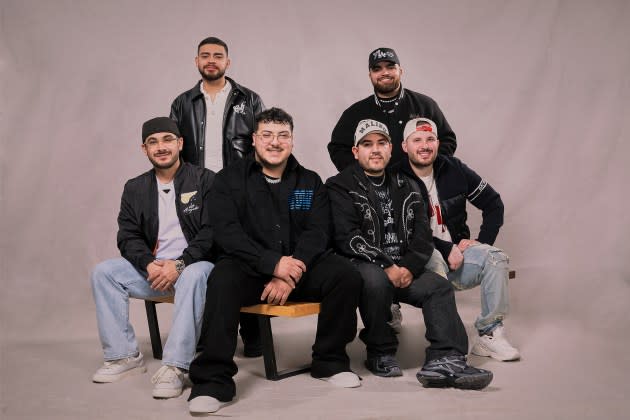Grupo Frontera Revived Cumbias Norteñas. Now, They’re ‘Trying Everything’
- Oops!Something went wrong.Please try again later.
- Oops!Something went wrong.Please try again later.

If you ask the members of Grupo Frontera why they’ve become such a phenomenon in música mexicana, they’ll probably say they’re just having fun.
“Cumbias, I don’t want to say we revived them,” says vocalist Payo Solis, looking hesitantly at his bandmates at first. Then he adds: “But when we started playing them, it gave the genre a whole new life.”
More from Rolling Stone
Grupo Frontera Refuses to Let Love Go on Emotional New Track 'Quédate Bebé'
Grupo Frontera, Marc Anthony, Sofia Reyes to Perform at 2023 Billboard Latin Music Awards
Manuel Turizo and Grupo Frontera Combine Their Star Power on 'De Lunes a Lunes'
Over the last year, the Texan band has rocketed to the top of Latin music, even joining Bad Bunny onstage at Coachella 2023 for a rendition of their collaboration “un x100to.” On their debut LP, El Comienzo, the group — comprising Solis, drummer Carlos Guerrero, guitarist Beto Acosta, percussionist Julian Peña, accordionist Juan Javier Cantú, and bassist Brian Ortega — tapped into a generation’s nostalgia for the accordion-backed norteño sound of the early 2000s, but modernized it through snappy lyricism about love in the modern age. It’s a thoroughly fresh spin on a familiar genre that keeps the romantic essence at its core.
Like the album title suggests in Spanish, the project was a thrilling start for Frontera. And lately, the group has been building on that foundation by experimenting in the studio, merging their signature style with muted drums, synths, and even steel guitars that bring George Strait to mind. “We were trying everything this time around,” Peña says. (They recently dropped a collaboration with Christian Nodal, bringing the fellow música mexicana star out of his comfort zone with the country-tinged norteña.)
Part of that genre exploration came from their producer, Edgar Barrera, who’s behind some of the biggest hits by Karol G, Don Omar, and Marc Anthony. “On El Comienzo, he wrote the songs but did our style. On this album, we let him flow with his musical ideas,” Guerrero says. “He’d be like, ‘You’re down to do that?’ And we really were. We really let him experiment.” (At times, Solis adds, “We were skeptical and thought, ‘How’s this going to sound?’ But honestly, we jam out to every song on the new album.”)
With just a few years under their belt, the group is just getting acclimated with the desmadre of the industry. They intend to take full advantage of the boom música Mexicana is having right now, and they also have a compadre-ship with many of the other artists blowing up with the genre, including Peso Pluma and Carin Leon. “The cool thing about being friends with them is we understand each other,” says Peña. “We can skip the small talk and get more intimate. ‘What’s going on with your tour?’”
After getting their start performing at weddings and quinceañeras in their native Rio Grande Valley, they’ve built a deep connection as bandmates. When they spoke to Rolling Stone, the group had just reunited after a two-week break.
“Right now we’re crying over here,” says Peña. “You can only be so apart from your brother for so long. If we hated each other, we couldn’t make this happen.”
Best of Rolling Stone
